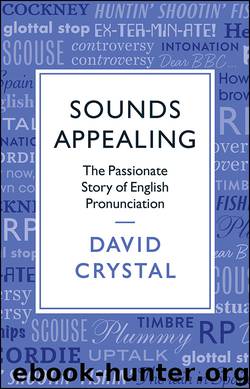Sounds Appealing by David Crystal

Author:David Crystal
Language: eng
Format: epub
Publisher: Profile
Published: 2018-10-01T16:00:00+00:00
Auditory check 7
Here are nine words each containing an initial consonant; four of them are affricates. Can you identify them? You can check your decisions on p. 278.
Affricate Not an affricate
show
char
see
jay
chip
tie
do
row
joe
19
The nasal family
Nasal sounds are among the most frequent of all the English consonants, yet are among the least noticed. Or perhaps I should say: they remain unnoticed until we find ourselves unable to pronounce them. Then we realize just how much we depend upon them.
There are only three: /m/ as in me, /n/ as in no, and /ŋ/ as in sing. They form an exact parallel to the series of plosive consonants, in terms of where they’re made in the mouth (p. 119). The lips close for /m/, just like /p/ and /b – the bilabial nasal. The blade of the tongue hits the alveolar ridge for /n/, just like /t/ and /d – the alveolar nasal. And the back of the tongue hits the back part of the roof of the mouth (the velum), just like /k/ and/g – the velar nasal. The only difference from plosives is that the soft palate is lowered, so that the air comes out through the nose – hence the name nasal. We don’t easily feel the raising and lowering, but if you say a word like button quickly, so that the n becomes an entire syllable – as /'bʌtn/ rather than pronouncing the /t/ clearly as in /'bʌtən/ – it’s possible to feel the soft palate move.
We only really get a sense of the role of the soft palate when our nose is blocked. That’s when we find ourselves unable to pronounce nasal consonants. Novelists make a brave effort to represent the effects, when their characters have a cold. Here’s Holpweed, in The Memors, apologizing to his boss: ‘I’b sorry, but I caa’d go oud.’ To interpret this, we have to ‘hear’ the sentence, and work out the equivalences: /m/ is replaced by /b/ in I’m; /n/ is replaced by /d/ in can’t. We can do it easily enough because we have all had a cold, and know how our speech can get ‘clogged’ as a consequence. But it’s somewhat difficult to read, so novelists tend to use the respelling technique only for short stretches.
There’s one big difference between nasal and plosive consonants in English: there are no voiceless nasals that change the meaning, in the way that plosives do (as in bin/pin). Another is that one of the nasals isn’t used in words in the same way as plosives: /m/ and /n/ do work in parallel, being found at the beginning, in the middle, and at the end of words (mad, image, rum; nip, inner, ran), but /ŋ/ is used only in the middle and at the end (singer, sing). There are no words beginning with ‘ng’, other than in rare foreign imports, such as the name of a type of African drum, ngoma, or the first name of the crime writer Ngaio Marsh – and most people pronounce such
Download
This site does not store any files on its server. We only index and link to content provided by other sites. Please contact the content providers to delete copyright contents if any and email us, we'll remove relevant links or contents immediately.
Cecilia; Or, Memoirs of an Heiress — Volume 1 by Fanny Burney(32436)
Cecilia; Or, Memoirs of an Heiress — Volume 2 by Fanny Burney(31871)
Cecilia; Or, Memoirs of an Heiress — Volume 3 by Fanny Burney(31856)
The Lost Art of Listening by Michael P. Nichols(7409)
Asking the Right Questions: A Guide to Critical Thinking by M. Neil Browne & Stuart M. Keeley(5644)
We Need to Talk by Celeste Headlee(5544)
On Writing A Memoir of the Craft by Stephen King(4863)
Dialogue by Robert McKee(4323)
Pre-Suasion: A Revolutionary Way to Influence and Persuade by Robert Cialdini(4150)
I Have Something to Say: Mastering the Art of Public Speaking in an Age of Disconnection by John Bowe(3842)
Elements of Style 2017 by Richard De A'Morelli(3307)
The Book of Human Emotions by Tiffany Watt Smith(3238)
Fluent Forever: How to Learn Any Language Fast and Never Forget It by Gabriel Wyner(3031)
Name Book, The: Over 10,000 Names--Their Meanings, Origins, and Spiritual Significance by Astoria Dorothy(2940)
Good Humor, Bad Taste: A Sociology of the Joke by Kuipers Giselinde(2904)
Why I Write by George Orwell(2875)
The Art Of Deception by Kevin Mitnick(2736)
The Grammaring Guide to English Grammar with Exercises by Péter Simon(2711)
Ancient Worlds by Michael Scott(2626)
